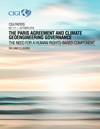-
Rising Seas Threaten Military Installations, and Elevating Human Rights to Mitigate Geoengineering Risks
December 16, 2016 By Sreya Panuganti A roughly three-foot increase in sea level will threaten 128 coastal military installations in the United States, valued at $100 billion, according to a study from the Union of Concerned Scientists. The report, The U.S. Military on the Front Lines of Rising Seas, argues that the growing exposure to storm surge and sea-level rise puts vital infrastructure, training and testing grounds, and housing for thousands of personnel at risk. Eighteen military installations were chosen for study based on their representation of coastal bases nationwide in terms of size, geographic distribution, and service branch. The evaluation revealed deficiencies in the military’s current level of preparedness. In the highest scenario, nearly half of the sites studied could lose over 50 percent of their land by 2100. The Union of Concerned Scientists calls on both the military and Congress to adequately fund monitoring systems; allocate resources to detailed mapping and planning efforts; and conduct detailed analyses for site-specific adaptation planning.
A roughly three-foot increase in sea level will threaten 128 coastal military installations in the United States, valued at $100 billion, according to a study from the Union of Concerned Scientists. The report, The U.S. Military on the Front Lines of Rising Seas, argues that the growing exposure to storm surge and sea-level rise puts vital infrastructure, training and testing grounds, and housing for thousands of personnel at risk. Eighteen military installations were chosen for study based on their representation of coastal bases nationwide in terms of size, geographic distribution, and service branch. The evaluation revealed deficiencies in the military’s current level of preparedness. In the highest scenario, nearly half of the sites studied could lose over 50 percent of their land by 2100. The Union of Concerned Scientists calls on both the military and Congress to adequately fund monitoring systems; allocate resources to detailed mapping and planning efforts; and conduct detailed analyses for site-specific adaptation planning. In a paper for the Center for International Governance Innovation, Wil Burns warns that geoengineering as a climate response is moving from the fringe to the mainstream of mitigation policy and these techniques pose potential human rights problems in a number of ways. Geoengineering is defined as efforts to enact large-scale manipulation of the environment through technological innovation. Some geoengineering techniques could reduce precipitation in some places, thereby displacing agricultural production and imperiling the right to water for some. Others could induce drought or deplete the ozone layer. The consequences of many geoengineering options will be felt beyond national borders, writes Burns, making it difficult to determine a state’s obligations under international human rights law. To combat this jurisdictional complexity, he calls for greater multilateral cooperation between the UN Framework Convention on Climate Change and the UN Commission on Human Rights to establish a monitoring and evaluation program and a human rights subsidiary body within the Paris Agreement. These mechanisms would assess geoengineering projects against human rights conventions, advise members of the Conference of Parties on relevant human rights standards and best practices, and seek to minimize harm to the world’s most vulnerable populations.
In a paper for the Center for International Governance Innovation, Wil Burns warns that geoengineering as a climate response is moving from the fringe to the mainstream of mitigation policy and these techniques pose potential human rights problems in a number of ways. Geoengineering is defined as efforts to enact large-scale manipulation of the environment through technological innovation. Some geoengineering techniques could reduce precipitation in some places, thereby displacing agricultural production and imperiling the right to water for some. Others could induce drought or deplete the ozone layer. The consequences of many geoengineering options will be felt beyond national borders, writes Burns, making it difficult to determine a state’s obligations under international human rights law. To combat this jurisdictional complexity, he calls for greater multilateral cooperation between the UN Framework Convention on Climate Change and the UN Commission on Human Rights to establish a monitoring and evaluation program and a human rights subsidiary body within the Paris Agreement. These mechanisms would assess geoengineering projects against human rights conventions, advise members of the Conference of Parties on relevant human rights standards and best practices, and seek to minimize harm to the world’s most vulnerable populations.Correction, January 4, 2017: An earlier version of the text miscited the extreme scenario of the Union of Concerned Scientists report.
Sources: Center for International Governance Innovation, Union of Concerned Scientists.
 A Publication of the Stimson Center.
A Publication of the Stimson Center.





